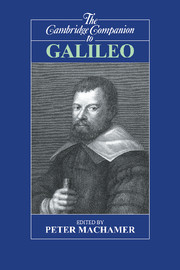Book contents
- Frontmatter
- Introduction
- 1 Galileo's Pisan studies in science and philosophy
- 2 Galileo's machines, his mathematics, and his experiments
- 3 The use and abuse of mathematical entities
- 4 Inertial problems in Galileo's preinertial framework
- 5 From Galileo to Augustine
- 6 Galileo's Copernicanism
- 7 Galileo's discoveries with the telescope and their evidence for the Copernican theory
- 8 Galileo on science and Scripture
- 9 Could there be another Galileo case?
- 10 The god of theologians and the god of astronomers
- 11 The never-ending Galileo story
- 12 The sepulchers of Galileo
- Bibliography
- Index
12 - The sepulchers of Galileo
The "living" remains of a hero of science
Published online by Cambridge University Press: 28 May 2006
- Frontmatter
- Introduction
- 1 Galileo's Pisan studies in science and philosophy
- 2 Galileo's machines, his mathematics, and his experiments
- 3 The use and abuse of mathematical entities
- 4 Inertial problems in Galileo's preinertial framework
- 5 From Galileo to Augustine
- 6 Galileo's Copernicanism
- 7 Galileo's discoveries with the telescope and their evidence for the Copernican theory
- 8 Galileo on science and Scripture
- 9 Could there be another Galileo case?
- 10 The god of theologians and the god of astronomers
- 11 The never-ending Galileo story
- 12 The sepulchers of Galileo
- Bibliography
- Index
Summary
Galileo died on January 8, 1642, in the unpleasant predicament of a man who had been condemned and then forced to abjure, as “vehemently suspected of heresy.” His will indicated that his remains should be placed beside those of his father Vincenzo and of his ancestors, in the Basilica of Santa Croce, where the family tomb can still be seen.
The death of such a remarkable person was not marked by solemn ceremonies or orations attesting either to his virtues as a man or to his sensational discoveries as a scientist and astronomer. On the day after his death, Galileo's body was removed to the Basilica of Santa Croce without the slightest hint of pomp or ceremony, accompanied by his son Vincenzo, by the Curate of S. Matteo in Arcetri, by Vincenzo Viviani, by Evangelista Torricelli, and by a few members of his family. The Grand Duke remained in Pisa, and no other important igures of Florentine public life made an appearance.
- Type
- Chapter
- Information
- The Cambridge Companion to Galileo , pp. 417 - 448Publisher: Cambridge University PressPrint publication year: 1998
- 6
- Cited by

